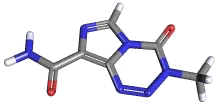|
TEMOZOLOMIDE |
| Synonyms. Temozolomide; Temodar; 3,4-Dihydro-3-methyl-4-oxoimidazo(5,1-d)-1,2,3,5-tetrazine- 8-carboxamide; 3,4-Dihydro-3-methyl-4-oxoimidazo(5,1-d)-as-tetrazine-8-carboxamide; 3-Methyl- 4-oxo-3,4-dihydroimidazo(5,1-d)(1,2,3,5)tetrazine-8-carboxamide; 8-Carbamoyl-3-methylimidazo (5,1-d) -1,2,3,5-tetrazin-4(3H)-one; Methazolastone; Temozolodida; Temozolomidum; Temodal; Temodar; |
|
|
| PRODUCT IDENTIFICATION | |
|
CAS RN |
85622-93-1 |
|
EINECS RN |
|
|
FORMULA |
C6H6N6O2 |
|
MOLE WEIGHT |
194.15 |
|
H.S CODE |
2933.99.9000 |
|
SMILES |
n1(nnc2n(c1=O)cnc2C(=O)N)C |
|
CLASSIFICATION |
Imidazotetrazine alkylating agent, Antineoplastic agent |
|
EXTRA NOTES |
Treatment of recurrent high-grade gliomas and advanced metastatic melanoma. Temozolomide is a DNA methylating agent and drug resistance-modifying agent; anti-tumor and anti-angiogenic. Temozolomide induces G2/M arrest and apoptosis through adduction of a methyl group to O6 position of guanine in genomic DNA and functional inactivation of DNA repair protein O(6)-alkylguanine DNA alkyltransferase (AGT) in base excision repair (BER) pathway. (SigmaAldrich) |
|
|
| PHYSICAL AND CHEMICAL PROPERTIES | |
|
PHYSICAL STATE. |
white to off-white crystalline powder |
|
MELTING POINT |
210 ~ 212 C |
|
BOILING POINT |
|
|
DENSITY |
|
|
SOLUBILITY IN WATER |
Insoluble |
| SOLVENT SOLUBILITY | Slightly soluble in acetone, DMSO: >20 mg/ml |
|
VAPOR DENSITY |
|
|
log P(octanol-water) |
|
|
VAPOR PRESSURE |
|
|
AUTOIGNITION TEMP |
|
| pK |
15.29 |
|
REFRACTIVE INDEX |
|
|
FLASH POINT |
|
|
|
| STABILITY AND REACTIVITY | |
| STABILITY | Stable under normal conditions. |
|
INCOMPATIBLE MATERIALS |
Strong oxidizing agents. |
| POLYMERIZATION |
Has not been reported |
|
NFPA RATINGS |
Health: 2, Flammability: 0, Reactivity: 0 |
|
|
| EXTERNAL LINKS & GENERAL DESCRIPTION |
|
Wikipedia Linking - Temozolomide Google Scholar Search - Temozolomide Drug Information Portal (U.S. National Library of Medicine) - Temozolomide PubChem Compound Summary - Temozolomide Drug Bank - Temozolomide KEGG (Kyoto Encyclopedia of Genes and Genomes) - Temozolomide http://www.ebi.ac.uk/ - Temozolomide http://www.ncbi.nlm.nih.gov/ - Temozolomide http://theoncologist.alphamedpress.org/ http://www.merck.com http://clincancerres.aacrjournals.org |
|
|
| SALES SPECIFICATION | |
|
APPEARANCE |
white to off-white crystalline powder |
|
ASSAY |
98.5% min |
|
MELTING POINT |
210 ~ 212 C |
| IMPURITY |
1.0% max (total), 0.5% max (individual) |
|
LOSS ON DRYING |
1.0% max |
|
HEAVY METALS |
20ppm max |
| RESIDUE ON IGNITION |
0.1% max |
|
|
| TRANSPORT & REGULATORY INFORMATION | |
|
UN NO. |
Not regulated |
| HAZARD CLASS |
|
| PACKING GROUP | |
|
|
| SAFETY INFORMATION |
|
|
HAZARD OVERVIEW |
Harmful by ingestion., Irritant. May cause cancer. May impair fertility. May cause harm to the unborn child. Harmful if swallowed. Irritating to eyes, respiratory system and skin. |
|
GHS |
|
|
SIGNAL WORD |
Danger |
|
PICTOGRAMS |
|
|
HAZARD STATEMENTS |
H302-H315-H319-H335-H350-H360 |
|
P STATEMENTS |
P201-P261-P305 + P351 + P338-P308 + P313 |
| EC DIRECTIVES |
|
| HAZARD CODES |
|
|
RISK PHRASES |
45-46-60-61-22-36/37/38 |
|
SAFETY PHRASES |
53-26-36/37-45 |
|
|
| PACKING |
|
|


